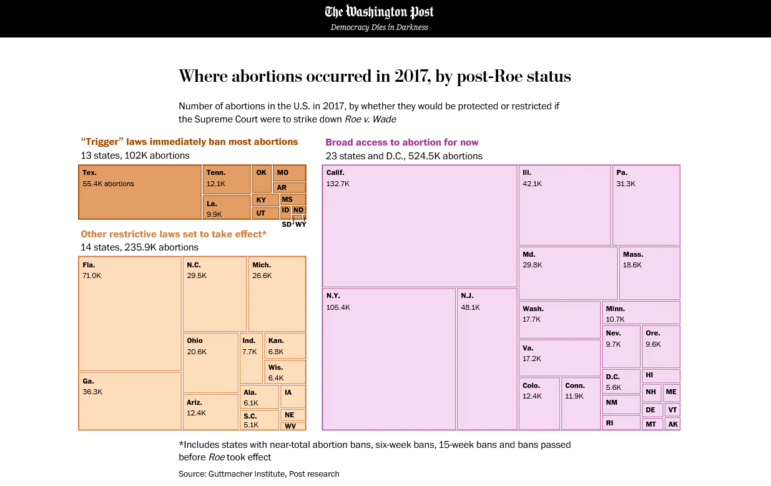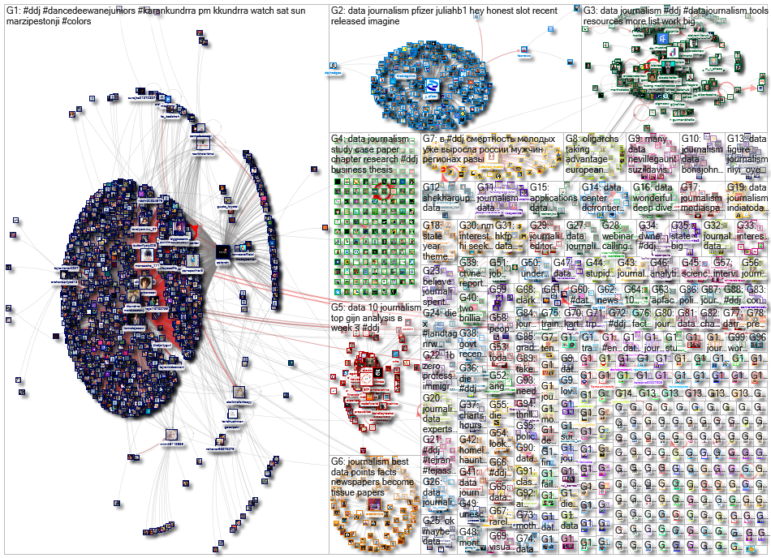
The Washington Post examines how overturning a judicial precedent protecting the right to abortion might affect child-bearing women in the country. Image: Screenshot.
A woman’s right to abortion is currently under threat in the United States. The Washington Post reports that 52% of women of childbearing age in the country live in states where their access to abortion might be reversed. Our weekly NodeXL and human curation of the most popular data journalism stories on Twitter also highlights an analysis by IStories showing that two-thirds of Russian soldiers killed in Ukraine come from poor areas, Axios’ visualization of one million COVID-19 deaths, The Wall Street Journal’s correlation of a dog’s breed to its behavior, and a list of suggestions to inspire data visualization.
Ripple Effects of Outlawing Abortion
Data journalists in the US have been busy analyzing and visualizing the potential blowback if the landmark Roe v. Wade decision — a judicial ruling that guarantees federal protection of abortion rights — is overturned by the Supreme Court. The Washington Post looked at how state abortion laws might change, and the number of abortions that would potentially become illegal if Roe is struck down. It also examined related laws and issues, including paid family leave, income for women, availability of child care, and maternal death rates.
How many abortions take place in states that would ban or restrict it post-Roe? A state-by-state look at the numbers via @Harry_Stevens @asteckelberg @dtkeating @bonnieberkowitz https://t.co/ZucYALTZLD
— PJ Joshi (@pjoshidc) May 5, 2022
War in Ukraine, as Spun on Russian TV
The Russian government criminalizes any mention of its country’s invasion of Ukraine as a “war” or an “invasion.” So how does its local media report on what’s happening? The New York Times reviewed more than 50 hours of Russian news footage, sourced from the Internet Archive’s TV News Archive, to find out how the war was being presented to Russian citizens within the country. The analysis discovered that Russian media spun different narratives of the war, ranging from downplaying Ukraine’s victories and Russia’s own casualties to dismissing incriminating events as hoaxes.
The @nytimes watched 50+ hours of TV to show how the war in Ukraine has been presented to Russians in the country’s media.
Brutal attacks and strategic blunders have been spun as positive steps, aided by a jumble of opinion and lies. @stuartathompson
https://t.co/5qJNOAPtLe— Danielle Ivory (@danielle_ivory) May 6, 2022
Deaths of Young Russian Soldiers
The Russian government has not been forthcoming in reporting on its military’s losses in the war on Ukraine. Its Ministry of Defense has only announced an official death toll twice, with the last estimate of 1,300-plus dead coming more than a month ago, on March 25. (NATO military officials estimated the number was up to 10 times higher.) Independent Russian news site IStories studied and verified messages about deceased Russian soldiers on the Telegram channel «Горюшко», and established at least 1,855 deaths. From its analysis, bluntly titled “Young, Poor, Dead,” IStories found that more than 80% of the deceased were between the ages of 18 and 35, and almost two-thirds were from small regional towns and villages with a below-average standard of living in Russia.
В маленьких населенных пунктах, откуда чаще всего были погибшие российские солдаты, зачастую нет даже базовых удобств и далеко не каждый может позволить себе купить нормальный телевизор или стиральную машину.#ddjhttps://t.co/tLVX3I134e pic.twitter.com/9IwQRQNI7R
— Важные истории (@istories_media) May 4, 2022
One Million COVID Deaths Visualized
It’s difficult to comprehend the magnitude of lives lost to the pandemic over the past two years, with the worldwide death toll having surpassed six million, and about one million of those deaths in the United States alone. The Axios Visuals team tried to capture the scale of loss by visualizing the rising death toll as a growing diamond that eventually expands beyond the borders of a webpage, and comparing COVID deaths to the number of casualties in notable events from US history.
A striking visual of the magnitude of loss we've experienced in the past two years in the US alone. A number reached through numerous administration failures, vaccine apartheid, and placing big pharma's interest>>people's wellbeinghttps://t.co/G9sUhGvQSD
— Michele Buonora (@mbuonora) May 11, 2022
Dog Breeds Dictate Behavior, Debunked
Do you think Rottweilers are naturally more aggressive? Or Labrador retrievers are always friendly? A team of researchers surveyed more than 18,000 dog owners and conducted genetic sequencing from more than 2,000 of their dogs — and revealed that a dog’s breed isn’t an accurate indicator of behavioral traits. Instead, the results suggest that socialization and experience play strong roles in shaping a dog’s nature and behavior. The Wall Street Journal visualized the research’s findings.
my latest 🗞: looking to add a dog to your family? don’t bank on friendliness just because it’s a Labrador. a new study shows breed is responsible for less than one-tenth of differences in behavior among thousands of dogs. https://t.co/TgJF1A2ni5
— Renée 🦋 (@reoxoo) April 28, 2022
Canary Islands Tax Shelters
The Canary Islands Special Zone in Spain offers extensive tax exemptions, and is a tax haven for businesses. El Diario examined the fiscal mechanisms in the area that make such low tax rates possible. It looked at how much tax businesses were paying in relation to their profits, and reported that businesses have saved around €5 billion (US$5.2 billion) in taxes in the last decade, thanks to this favorable set-up.
🇮🇨Hoy publicamos en @elDiarioes una investigación en la que llevamos tiempo trabajando y que es casi un tabú hablar en el archipiélago.
🏝El edén fiscal canario: empresas y fortunas de las Islas se ahorran 5.000 millones en impuestos desde 2008https://t.co/qDkiXGGpKi
— Raúl Sánchez 📈 (@raulsanchezglez) May 2, 2022
High-Risk Dams
According to a data analysis by Deutsche Welle, about one million Brazilians live near high-risk dams. It reported that 1,220 such structures were potentially dangerous because they lacked proper maintenance or government oversight. In addition to neglected state infrastructure, Deutsche Welle also highlighted concerns about “orphaned” dams, where the person or organization responsible for the structure is unknown or no longer actively takes care of it. The journalists also looked at, and mapped, previous major dam incidents.
1 million Brazilians are living within 1 km of a dam (tailings or water retention) the Brazilian government considers to be high risk with potential for severe consequences in the case of a failure. https://t.co/ZXplBIn0nA
— Jan Morrill (@MorrillJB) May 3, 2022
India Heat Wave
Temperatures in some parts of India reached record levels in recent weeks, with New Delhi hitting seven consecutive days above 40 degrees Celsius (104 degrees Fahrenheit) last month. Stats of India visualized the scorching temperatures across the country, and the estimated number of affected people.
Close to a billion people in India experienced ≥ 40°C temperature in India last month. pic.twitter.com/J533eGt5Y9
— Stats of India (@Stats_of_India) May 5, 2022
Python Vs. R
Which programming language do you prefer: Python or R? Datajournalism.com intern Simona Bisiani wrote a comparison of both languages, highlighting the pros and cons of each, and offers her take on whether journalists should learn one, or both.
It’s time to take a side in the storied #datajournalism argument!
First: Do we need coding?
Next: #R or #Python? @BisianiSimona unfolds the debate in our latest blogpost👉https://t.co/WQbA9BLg4J #ddj pic.twitter.com/CDBzYEUEes
— DataJournalism.com (@datajournalism) May 2, 2022
Dataviz Inspiration
Stephanie Evergreen, author of three books on data visualization, reached out to her followers on LinkedIn for suggestions of their favorite places to seek inspiration. She collated the responses in a Twitter thread, pointing out some great sites to monitor (The Pudding, FiveThirtyEight, and Information is Beautiful among them), as well as interesting individuals in the data visualization space to follow, such as Nathan Yau, Mona Chalabi, and Alberto Cairo.
A workshop student asked me for places to go to see collections of great data viz (he said he goes to Reddit's dataisbeautiful 🫤). I asked my LinkedIn followers for their suggestions and this is a thread of their go-to viz inspo spots.
— Stephanie Evergreen (@evergreendata) May 2, 2022
Thanks again to Marc Smith and Harald Meier of Connected Action for gathering the links and graphing them. The Top Ten #ddj list is curated weekly.
 Eunice Au is GIJN’s program manager. Previously, she was a Malaysia correspondent for Singapore’s The Straits Times, and a journalist at the New Straits Times. She has also written for The Sun, Malaysian Today, and Madam Chair.
Eunice Au is GIJN’s program manager. Previously, she was a Malaysia correspondent for Singapore’s The Straits Times, and a journalist at the New Straits Times. She has also written for The Sun, Malaysian Today, and Madam Chair.

